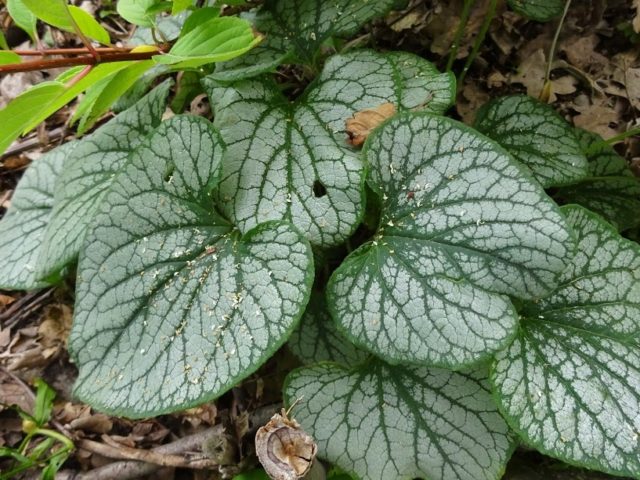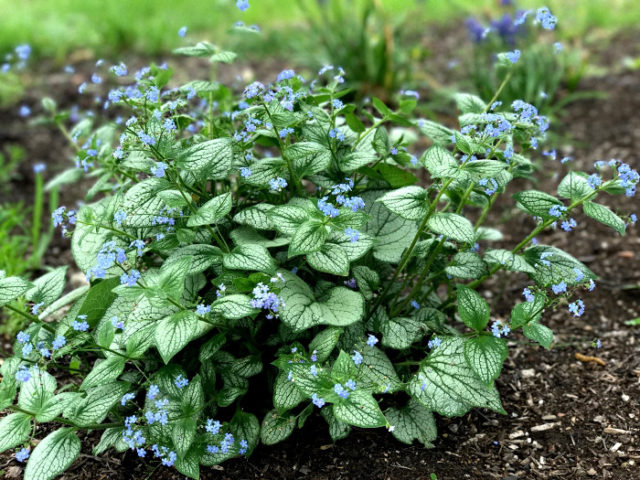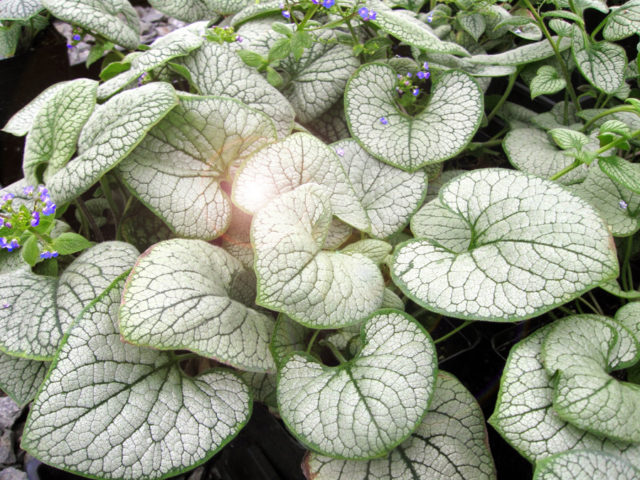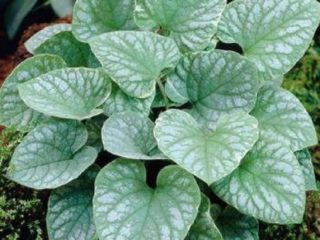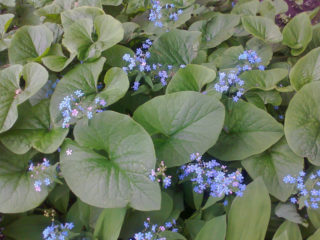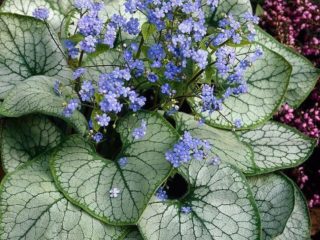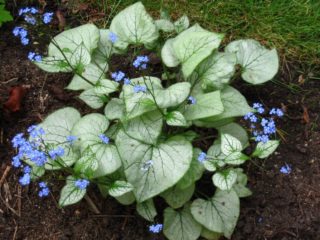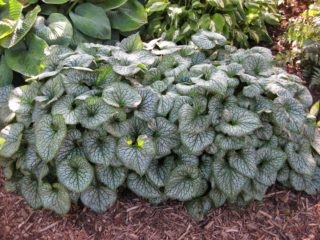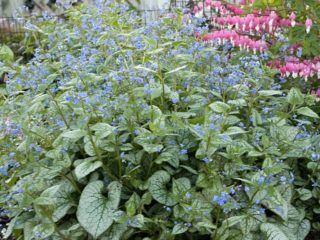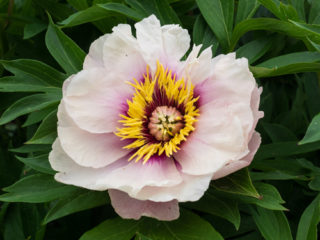Content
Popular varieties and types of brunner with a photo and name will help gardeners choose the right crop for growing. The decorativeness of the plant is associated with very beautiful, large leaves that attract attention with their original shape and color.
Description of brunner with photo
Brunner is a perennial flowering shrub from the Borage family with decorative large leaves. They are round or heart-shaped in shape, they can reach 15-20 cm in width. They are painted in different colors: from light to dark green, sometimes with a cream or light yellow border.
Brunner's bloom lasts from mid-May to the second half of July, sometimes a little longer. Small flowers - up to 0.5-1 cm in diameter, with five petals. Painted in rich blues and blues. The plant attracts attention not with flowers, but with leaves. The height of the brunner (depending on the variety) ranges from 20 to 60 cm. The bushes are compact in width (no more than 40-50 cm in diameter).
Under natural conditions, the flower grows in warm climatic zones - the Caucasus, Transcaucasia, Turkey, Southeast Asia. Thanks to breeding work, many cultivars tolerate winter frosts well (down to -35-40 ° C). Brunner's care is undemanding, however, when choosing a plant, you must definitely pay attention to its frost resistance.
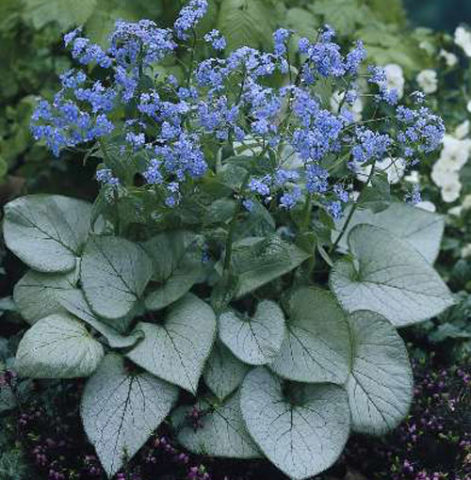
Brunner is decorative not only for its flowers, but also for the leaves of an unusual color.
Types and varieties of brunner
The culture includes only 3 species. There are Siberian, large-leaved and eastern brunner. In turn, the species are represented by several varieties, many of which are used to decorate the garden.
Brunner siberian
This culture is often found in the forests of Altai and the foothills of the Sayan Mountains. Therefore, Brunner was named Siberian. Decorative thanks to the beautiful lanceolate leaves of a rich green color. When densely planted, it forms thickets that completely cover the soil. The brunner photo shows that this plant has graceful, small flowers with a diameter of up to 0.5 cm of sky-blue color.
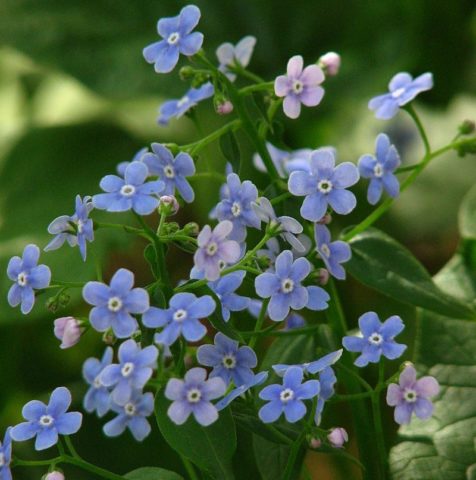
Brunner Siberian blooms from the second half of May to mid-July
Brunner large-leaved
This type of culture (as the name suggests) is distinguished by huge leaves reaching 20 cm in width. At the same time, the flowers of the plant are similar to forget-me-nots, which is why sometimes Brunner is called that way. The leaves are rounded, with red petioles contrasting well against the greenery.
The most common plant varieties:
- Brunner Jack Frost - a very showy bush with silvery leaves. They "refresh" the look: you can easily imagine that snow has passed in the garden and the plant is covered with frost.
- Millennium Zilber - brunner with light green large leaves. Their surface is also covered with a white "bloom", which creates an interesting relief effect. Leaves are cordate, whole. This Brunner variety is unpretentious, but prefers abundant watering and shading.
- Hudspan Cream - Brunner variety with large heart-shaped leaves. They are easily distinguished by their characteristic light yellow border (the rest of the surface is light green). The variety is moderately winter hardy, therefore it is grown mainly in the regions of Central Russia.
- Variegata - another interesting large-leaved brunner with dark green leaves, along the edges of which you can see a pale yellow border.The plant is characterized by good winter hardiness, it can withstand even severe frosts down to -40 ° C, which makes it possible to plant bushes in Siberia and the Urals.
5. Lukin glass (Brunnera macrophylla Looking Glass) is a short shrub (up to 35 cm) with silvery leaves. Looks good in the shade of large trees, and slightly shaded areas are also suitable for planting. Perfectly harmonizes in compositions with other plants (rockeries, rock gardens, borders).
- Sea Heart - brunner with large light green leaves and a whitish bloom covering the edges. The flowers are heavenly and deep blue. The bush is compact, no more than 50 cm in diameter, reaches 40 cm in height.
- Brunner Mr. Morse similar to the Jack Frost variety, as can be seen from the photo and description. The leaves are large, silvery, with dark green veins and edging. The flowers are bright blue, sometimes the color is closer to blue, small (up to 5 mm in diameter).
Brunner east
This species is found only in the wild, mainly in the Middle East. It is not decorative, therefore it is not grown in culture. In addition, it is distinguished by its thermophilicity - the plant is not common in Russia.
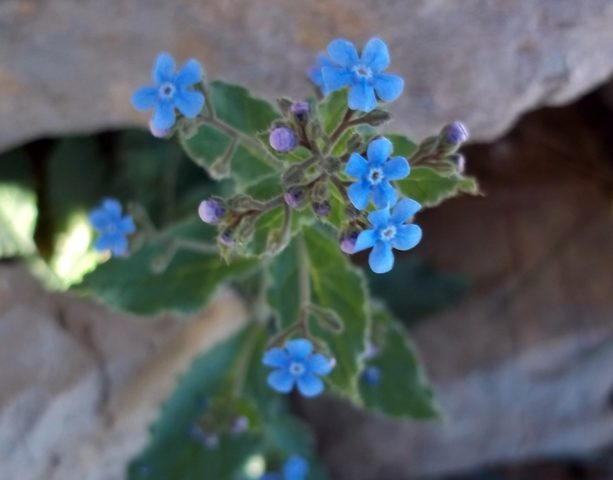
Eastern Brunner has thin, nondescript leaves, so it is not used in landscape design
Brunners in landscape design
Many flower growers like Brunner because it can be planted in the garden almost anywhere. This is an unpretentious plant that feels good even in strong shade and on waterlogged soil. Therefore, with its help, they usually decorate nondescript, distant corners of the flower garden.
Along with single plantings, Brunner is used in garden design in combination with different plants. Flowerbed neighbors can be:
- hosts;
- dwarf conifers;
- ferns;
- astilba;
- geychera;
- lungwort;
- delphinium;
- hellebore and others.
Brunner looks beautiful along the paths, in plantings on the coast of reservoirs, in the trunk circles of large trees.

With the help of a brunner planted along the garden paths, you can create natural fences

The culture can be planted in the recreation area by placing it next to the bench
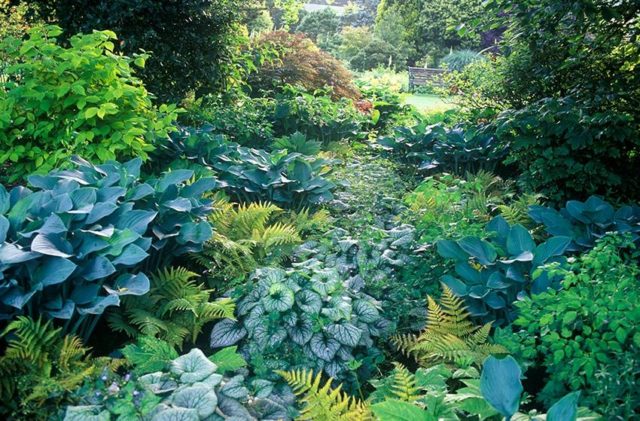
The composition of brunner and fern always looks spectacular
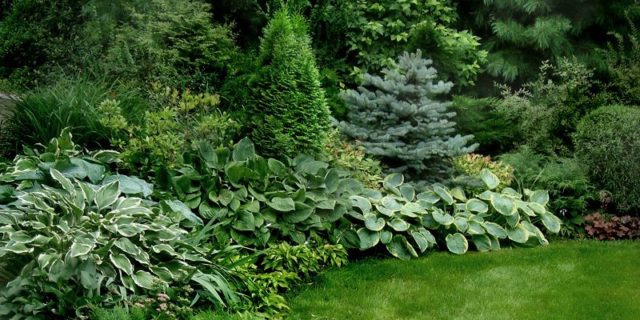
The plant can be placed in the shade of conifers
How brunner reproduces
The flower is propagated in two ways:
- Seeds.
- By dividing the bush.
The first option is quite laborious, besides, the new plant may not inherit the characteristics of the maternal one, but this is not observed in the case of vegetative propagation. Seeds are sown in open ground in autumn, late September or early October. Superphosphate with potassium salt or wood ash is preliminarily introduced into the dug soil. The seed is sprinkled with earth a little, watered, then mulched. The first shoots appear in the spring. They can be transplanted to a permanent place towards the end of the summer.
Also, Brunner seedlings can be grown from seeds. To do this, use any containers and universal soil. The culture is planted in early March, put in a warm place and covered with foil. Water abundantly, illuminate with a lamp, then gradually lower the temperature. Plants are transplanted into open ground in early or mid-May.
Dividing a bush is the easiest way. An adult plant at the age of 3-4 years is dug up in the second half of summer and divided into several parts, so that each has 2-3 healthy shoots. Then they are planted in a permanent place and grown in the same way as the mother bush. The first inflorescences appear the next season.
Brunner's landing
I plant Brunner in the same way as other ornamental plants. Pre-select a place: shade or partial shade. In this case, no special fertilizers are needed. The flower is unpretentious and takes root even on heavy soils.
Timing
Brunner should not be planted in spring and autumn. If you plant it early, it can suffer from diseases, and if it is too late, it will not have time to take root. Therefore, the optimal time is the whole of July and the beginning of August.This time is suitable for planting a plant in any region, regardless of climatic conditions.
Site selection and soil preparation
The place for planting a flower should be:
- well shaded (partial shade is also allowed), for example, under trees, next to large bushes, not far from a house, a fence and other buildings;
- well hydrated. You can even choose lowlands, in which it is usually not recommended to plant most other crops;
- decorative - Brunner is often placed not in the center of the garden, but in remote places, where it creates a good background and fills the space;
- as far as possible protected from strong winds.
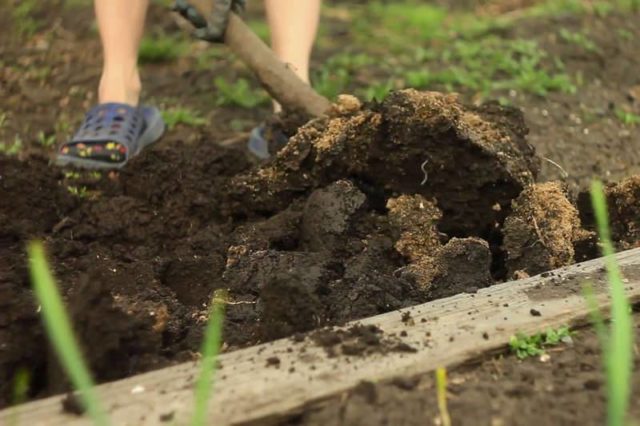
1-2 weeks before planting, the site is cleaned and dug up
If the soil is infertile, apply 50-60 g of complex mineral fertilizer per 1 m2 and watered abundantly. Instead, you can add 1.5-2 kg of humus or a few pinches of wood ash (also per 1 m2). If the soil is light and fertile, additional fertilizing is not necessary.
Landing algorithm
After preparing the site, it is necessary to form several holes of small depth (guided by the rhizome) at a distance of 30-40 cm. Most Brunner bushes do not grow more than 50 cm in diameter, so this interval will be sufficient. However, it can be reduced to 15-20 cm. The planting will be tighter, resulting in a pleasant green carpet with graceful flowers.
The sequence of actions when placing a plant:
- Plants are rooted one copy per hole.
- If the soil has not been previously fertilized, a tablespoon of superphosphate and potassium salt is embedded in the soil.
- Fall asleep, lightly tamp.
- Water abundantly.
- Mulch with peat, humus, foliage, sawdust or other materials.
Care features
Judging by the reviews of experienced gardeners, it is very easy to grow a Brunner - this is one of the ornamental plants that does not cause much trouble. The main condition is to ensure regular watering.
Watering and feeding schedule
All types and varieties of Brunners love regular, plentiful watering. It must be organized so that the soil surface does not dry out completely and does not crack. If the rains are heavy, the plant does not need additional moisture. If precipitation is rare or drought is established, water the crop at least 1 or 2 times a week. To do this, use settled water at room temperature. In hot weather, you can also spray brunner leaves. It is advisable to do this in the evening.
The flower does not need special feeding. Experienced summer residents advise scattering several granules of complex fertilizer every spring - even on the snow. There is no need to feed the plants in the future.
Weeding
Brunner does not like the neighborhood of weeds, moreover, they spoil the view. Therefore, weeding should be done regularly, preferably before each watering. Then the water will quickly reach the roots, and then spread throughout the plant.

A layer of mulch made from wood chips, sawdust, straw or other materials will help prevent weeds from growing.
Post-flowering care
The plant stops blooming in the first half of July. Therefore, all flower stalks should be completely cut using scissors or pruning shears. Damaged crop stems can be sprinkled with charcoal or activated carbon powder. Brunner does not need additional care after flowering.
Preparing for winter
Many varieties of Brunner are winter-hardy. But in most regions of the middle zone and especially the Urals, Siberia, the Far East, plants need to be prepared for winter. For this:
- At the end of September, the bushes are watered abundantly.
- After a week, cut off all the leaves, leaving stumps 2-3 cm above the ground.
- Mulch with dry foliage, sawdust, hay, humus or other materials.
In addition, you do not need to cover the brunner with burlap. The mulch layer will need to be removed at the end of March so that the plant does not overwhelm.
Forcing flowers for the holidays
Forcing - accelerating growth and stimulating the production of flowers at the right time, for example, for the holidays.All Brunner varieties bloom in the summer months (roughly June and July). Therefore, to obtain flowers, for example, in December, forcing begins in early October.
Sequencing:
- A nutrient mixture is prepared, for example, you can take sod land, mix it with peat, humus and compost in equal amounts.
- It is well crushed, loosened and watered.
- Placed in any container (it is convenient to use a flowerpot).
- Rhizomes are planted and left outside to harden.
- As soon as the first frosts come (the temperature drops to 5 degrees Celsius and below), the containers must be transferred to the utility room.
- Then they are grown at a temperature not higher than 5-7 ° C, always with good lighting.
- As soon as the green arrows appear, the temperature can be raised to 10-12 degrees. In such conditions, the first flowers will appear in mid-December.
Pests and diseases
Brunner needs regular watering, so she can suffer from fungal infections - from brown spot and powdery mildew. To prevent this from happening, it is recommended to treat the bushes with a fungicide in April or May, for example, Bordeaux liquid, preparations "Maxim", "Topaz", "Tattu" (one to choose from).
In summer, the flower can suffer from an invasion of insects: whiteflies and aphids. If found, you must immediately spray the leaves with insecticides: "Biotlin", "Decis", "Actellik", "Fufanon" and others.

To eliminate insects, you can use folk remedies - infusion of onion peels, chopped garlic, chili pepper, baking soda solution, shavings of laundry soap
Conclusion
Having studied the presented varieties and types of brunner with a photo and a name, each gardener will be able to choose a suitable culture for decorating the site. Almost all varieties can be grown in Russia - both in the middle lane and in Siberia, in the Urals. The flower requires almost no maintenance, except for regular watering and loosening. But the plant perfectly fills empty spaces and makes the garden more attractive.
https://youtu.be/F9lxAjP_2zY
